Neoteny in humans
Neoteny in humans is the slowing or delaying of body development, compared to non-human primates, resulting in features such as a large head, a flat face, and relatively short arms and legs. These neotenic changes may have been brought about by sexual selection in human evolution. In turn, they may have permitted the development of human capacities such as emotional communication. However, humans also have relatively large noses and long legs, both peramorphic (not neotenic) traits.
Overview
In humans, neotenic traits include several features of the head, including the globular skull[3] thinness of skull bones;[4] the reduction of the brow ridge;[5] the large brain;[5] the flattened [5] and broadened face;[4] the hairless face;[6] hair on (top of) the head;[3] larger eyes;[7] ear shape;[3] small nose;[6] small teeth;[5] and the small maxilla (upper jaw) and mandible (lower jaw).[5]
Neoteny of the human body is indicated by glabrousness (hairless body).[5] Neoteny of the genitals is marked by the absence of a baculum (penis bone);[3] the presence of a hymen;[3] and the forward-facing vagina.[3] Neoteny in humans is further indicated by the limbs and body posture, with the limbs proportionately short compared to torso length;[4] longer leg than arm length;[8] the structure of the foot;[3] and the upright stance.[9][10]
Human evolution

Many prominent evolutionary theorists propose that neoteny has been a key feature in human evolution. Stephen Jay Gould believed that the "evolutionary story" of humans is one where we have been "retaining to adulthood the originally juvenile features of our ancestors".[12] J. B. S. Haldane mirrors Gould's hypothesis by stating a "major evolutionary trend in human beings" is "greater prolongation of childhood and retardation of maturity."[5] Delbert D. Thiessen said that "neoteny becomes more apparent as early primates evolved into later forms" and that primates have been "evolving toward flat face."[13] However, in light of some groups using arguments based around neoteny to support racism, Gould also argued "that the whole enterprise of ranking groups by degree of neoteny is fundamentally unjustified" (Gould, 1996, pg. 150).[14]
Doug Jones, a visiting scholar in anthropology at Cornell University, said that human evolution's trend toward neoteny may have been caused by sexual selection in human evolution for neotenous facial traits in women by men with the resulting neoteny in male faces being a "by-product" of sexual selection for neotenous female faces. Jones said that this type of sexual selection "likely" had a major role in human evolution once a larger proportion of women lived past the age of menopause. This increasing proportion of women who were too old to reproduce resulted in a greater variance in fecundity in the population of women, and it resulted in a greater sexual selection for indicators of youthful fecundity in women by men.[15]
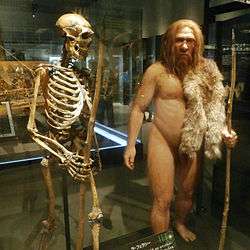
The anthropologist Ashley Montagu said that the fetalized pithecanthropine represented by the juvenile Mojokerto skull and the fetalized australopithecine represented by the juvenile Australopithecus africanus skull would have had skulls with a closer resemblance to those of modern humans than to those of the adult forms of their own species. Montagu further listed the roundness of the skull, thinness of the skull bones, lack of brow ridges, lack of sagittal crests, form of the teeth, relative size of the brain and form of the brain as ways in which the juvenile skulls of these human ancestors resemble the skulls of adult modern humans. Montagu said that the retention of these juvenile characteristics of the skull into adulthood by australopithecine or pithecanthropine could have been a way that a modern type of human could have evolved earlier than what actually happened in human evolution.[17]
The psychiatrist Stanley Greenspan and Stuart G. Shanker proposed a theory in The First Idea of psychological development in which neoteny is seen as crucial for the "development of species-typical capacities" that depend upon a long period of attachment to caregivers for the opportunities to engage in and develop their capacity for emotional communication. Because of the importance of facial expression in the process of interactive signaling, neotenous features, such as hair loss, allow for more efficient and rapid communication of socially important messages that are based on facially expressive emotional signaling.[18]
Other theorists have argued that neoteny has not been the main cause of human evolution, because humans only retain some juvenile traits, while relinquishing others.[19] For example, the high leg-to-body ratio (long legs) of adult humans as opposed to human infants shows that there is not a holistic trend in humans towards neoteny when compared to the other great apes.[19][20] Andrew Arthur Abbie agrees, citing the gerontomorphic fleshy human nose and long human legs as contradicting the neoteny hominid evolution hypothesis, although he does believe humans are generally neotenous.[9] Brian K. Hall also cites the long legs of humans as a peramorphic trait, which is in sharp contrast to neoteny.[21]
On the balance, an all or nothing approach could be regarded as pointless, with a combination of heterochronic processes being more likely and more reasonable (Vrba, 1996).
Growth pattern of children
Desmond Collins who was an Extension Lecturer of Archaeology at London University[22] said that the lengthened youth period of humans is part of neoteny.[16]
Physical anthropologist Barry Bogin said that the pattern of children's growth may intentionally increase the duration of their cuteness. Bogin said that the human brain reaches adult size when the body is only 40 percent complete, when "dental maturation is only 58 percent complete" and when "reproductive maturation is only 10 percent complete". Bogin said that this allometry of human growth allows children to have a "superficially infantile" appearance (large skull, small face, small body and sexual underdevelopment) longer than in other "mammalian species". Bogin said that this cute appearance causes a "nurturing" and "care-giving" response in "older individuals".[23]
Neotenous features elicit help
The Multiple Fitness Model proposes that the qualities that make babies appear cute to adults additionally look "desirable" to adults when they see other adults. Neotenous features in adult females may help elicit more resource investment and nurturing from adult males. Likewise, neotenous features in adult males may similarly help elicit more resource investment and nurturing from adult females in addition to possibly making neotenous adult males appear less threatening and possibly making neotenous adult males more able to elicit resources from "other resource-rich people". Therefore, it could be adaptive for adult females to be attracted to adult males that have "some" neotenous traits.[24]
Caroline F. Keating et al. tested the hypothesis that adult male and female faces with more neotenous features would elicit more help than adult male and female faces with less neotenous features. Keating et al. digitally modified photographs of faces of African-Americans and European Americans to make them appear more or less neotenous by either enlarging or decreasing the size of their eyes and lips. Keating et al. said that the more neotenous white male, white female and black female faces elicited more help from people in the United States and Kenya, but the difference in help from people in the United States and Kenya for more neotenous black male faces was not significantly different from less neotenous black male faces.[25]
Brain
The developmental psychologist Helmuth Nyborg said that a testable hypothesis can be made using his General Trait Covariance-Androgen/Estrogen (GTC-A/E) model with regards to "neoteny". Nyborg said that the hypothesis is that "feminized", slower maturing, "neotenic" "androtypes" will differ from "masculinized", faster maturing "androtypes" by having bigger brains, more fragile skulls, bigger hips, narrower shoulders, less physical strength, live in cities (as opposed to living in the countryside) and by receiving higher performance scores on ability tests. Nyborg said that if the predictions made by this hypothesis are true, then the "material basis" of the differences would be "explained". Nyborg said that some ecological situations would favor the survival and reproduction of the "masculinized," faster maturing "androtypes" due to their "sheer brutal force" while other ecological situations would favor the survival and reproduction of the "feminized," slower maturing, "neotenic" "androtypes" due to their "subtle tactics."[26]
Aldo Poiani who is an evolutionary ecologist at Monash University, Australia,[27] said that he agrees that neoteny in humans may have become "accelerated" through "two-way sexual selection" whereby females have been choosing smart males as mates and males have been choosing smart females as mates.[28]
Neoteny has been important to human evolution, because it has increased the maturation period and the size of the human brain. Two to three million years ago, there was an "incomplete segmental duplication of [the] ancestral SRGAP2" gene in the ancestors of humans. This new gene, SRGAC2, slowed spine maturation and allowed for more neuronal migration. As a result, the dendrite spines increased in number and length, and they became "more complex". This accounts for the greater synaptic densities in humans when compared to other primates and rodents.[29]
Somel et al. said that 48% of the genes that affect the development of the prefrontal cortex change with age differently between humans and chimpanzees. Somel et al. said that there is a "significant excess of genes" related to the development of the prefrontal cortex that show "neotenic expression in humans" relative to chimpanzees and rhesus macaques. Somel et al. said that this difference was in accordance with the neoteny hypothesis of human evolution.[30]
Dr. Bruce Charlton, a Newcastle University psychology professor, said what looks like immaturity — or in his terms, the "retention of youthful attitudes and behaviors into later adulthood" — is actually a valuable developmental characteristic, which he calls psychological neoteny.[31] In fact, the ability of an adult human to learn is considered a neotenous trait.[32]
Between sexes
Ashley Montagu said that the following neotenous traits are in women when compared to men: more delicate skeleton, smoother ligament attachments, smaller mastoid processes, reduced brow ridges, more forward tilt of the head, narrower joints, less hairy, retention of fetal body hair, smaller body size, more backward tilt of pelvis, greater longevity, lower basal metabolism, faster heartbeat, greater extension of development periods, higher pitched voice and larger tear ducts.[5]
A 2007 book about forensic anthropology said that the post-pubescent "female skull tends to retain its more pedomorphic features" when compared to the post-pubescent male skull.[33]
Attractive women's faces
In a cross-cultural study, more neotenized female faces were the most attractive to men while less neotenized female faces were the least attractive to men, regardless of the females' actual age.[34] Using a panel of Asian, Hispanic and White judges, Michael R. Cunningham found that the Asian, Hispanic and white female faces found most attractive were those that had "neonate large eyes, greater distance between eyes, and small noses"[35] and his study led him to conclude that "large eyes" were the most "effective" of the "neonate cues".[35] Cunningham also said that "shiny" hair may be indicative of "neonate vitality".[35]
Cunningham said that there was a "difference" in the preferences of Asian and White judges. Cunningham said that Asian judges preferred women with "less mature faces" and smaller mouths than the White judges.[35] Cunningham hypothesized that this difference in preference may stem from "ethnocentrism" since "Asian faces possess those qualities", so Cunningham re-analyzed the data with "11 Asian targets excluded" and he concluded that "ethnocentrism was not a primary determinant of Asian preferences."[35] Using a panel of Blacks and Whites as judges, Cunningham said that more neotenous faces were perceived as having both higher "femininity" and "sociability".[35]
In contrast, Cunningham said that faces that were "low in neoteny" were judged as "intimidating".[35] Upon analyzing the results of his study Cunningham concluded that preference for "neonate features may display the least cross-cultural variability" in terms of "attractiveness ratings".[35] In a study of Italian women who have won beauty competitions, the study said that the women had faces characterized by more "babyness" traits compared to the "normal" women used as a reference.[36] In a study of sixty Caucasian female faces, the average facial composite of the fifteen faces considered most attractive differed from the facial composite of the whole by having a reduced lower facial region, a thinner jaw, and a higher forehead.[37]
Doug Jones, a visiting scholar in anthropology at Cornell University, said that there is cross-cultural evidence for preference for facial neoteny in women, because of sexual selection for the appearance of youthful fecundity in women by men. Jones said that men are more concerned about women's sexual attractiveness than women are concerned about men's sexual attractiveness. Jones said that this greater concern over female attractiveness is unusual among animals, because it is usually the females that are more concerned with the male's sexual attractiveness in other species. Jones said that this anomalous case in humans is due to women living past their reproductive years and due to women having their reproductive capacity diminish with age, resulting in the adaption in men to be selective against physical traits of age that indicate lessening female fecundity. Jones said that the neoteny in women's faces may be a "by-product" of men's attraction to indicators of "youthful fecundity" in "adult females".[15]
A similar study was conducted on the attractiveness of males with the subject of the skull and its application in human morphology. Paul Wehr and team (2001) utilized psychology and evolutionary biology to understand selection on facial features. Averageness has been a result of stabilizing selection whereas facial paedomorphosis or juvenile traits are a result of directional selection (Wehr, 2001). It is necessary at this point to define several terms to put them into practical time and space, as they pertain to this argument. The idea of directional selection as defined by Bergstrom and Dugatkin (2012) is when a single phenotypic trait is driven by selection toward fixation in a population (Bergstrom and Dugatkin, p. 218). In contrast, stabilizing selection is defined as being a scenario wherein both alleles are driven toward fixation in a population (or polymorphic, both alleles reaching equilibrium at a fixation) (Bergstrom and Dugatkin, p. 221). To compare the effects of directional and stabilizing selection on facial paedomorphosis Wehr used graphic morphing to alter appearances to make faces appear more or less juvenile. The results concluded that the effect of averageness was preferred nearly twice over juvenile trait characteristics which indicates that stabilizing selection influences facial preference, and averageness was found more attractive than the retention of juvenile facial characteristics (Wehr, 2001). This follows the conclusions of the other study presented previously. It was perplexing to find that women tend to prefer the average facial features over the juvenile, because in animals the females tend to drive sexual selection by female choice and the Red Queen hypothesis. Some may hypothesize this is because in humans women tend to focus on social features including education, job status, family background, humor, and courtships. Experiments have found males tend to focus on the attractiveness of women, whereas women focus of overall quality and verbal interactions.
Because men generally exhibit uniform preference for neotenous women's faces, Elia (2013) questioned if women's varying preferences for neotenous men's faces could "help determine" the range of facial neoteny in humans.[38]
Between races, ethnicities and among primates
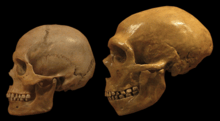
Trying to rescue Louis Bolk's theory, Stephen Jay Gould objected to the ranking of races as more or less neotenous, but Gould argued that if one used the terms set forth by 1920s proponents of racial neoteny, "Asians" are "clearly" the most neotenized human "race".[14]
Ashley Montagu said that the "Mongoloid skull, whether Chinese or Japanese" is the most neotenized human skull,[5] and Montagu added that "Chinese peoples" are "perhaps" the best representatives of neoteny out of the Mongoloids.[39] Montagu further said that the "European" skull was less neotenized than the Mongoloid, with the "Australian Aborigine" skull less neotenized than the European and the Neanderthal skull even less neotenized than the Australian Aborigine skull.[5] Montagu said that humans have more neotenized skulls than Australopithecus[17] and gorillas.[39]
Delbert D. Thiessen said that Homo sapiens are more neotenized than Homo erectus, Homo erectus was more neotenized than Australopithecus, Great Apes are more neotenized than Old World monkeys and Old World monkeys are more neotenized than New World monkeys.[13]
Nancy Lynn Barrickman said that Brian T. Shea concluded by multivariate analysis that Bonobos are more neotenized than the common chimpanzee, taking into account such features as the proportionately long torso length of the Bonobo.[40] Ashley Montagu said that part of the differences seen in the morphology of "modernlike types of man" can be attributed to different rates of "neotenous mutations" in their early populations.[41]
Regarding behavioral neoteny, Mathieu Alemany Oliver says that neoteny partly (and theoretically) explains stimulus seeking, reality conflict, escapism, and control of aggression in consumer behavior.[42] However if these characteristics are more or less visible among people, Alemany Oliver argues, it is more the fact of cultural variables than the result of different levels of neoteny. Such a view makes behavioral neoteny play a non-significant role in gender and race differences, and puts an emphasis on culture.
San people
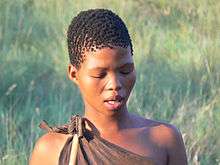
Neoteny has also been a subject of study for anthropologists engaging in racial classification. While the practice, like the articles cited below, is largely outmoded, the researcher's work sheds light on how neoteny has been used to claim racial superiority, by showing that the San were a less physically developed, childlike race. This research could then be used to demonstrate why the "Bushmen" were technologically or culturally 'backwards', and it is clear how such arguments feed on and into the racist logic of Apartheid.
Ashley Montagu said that the San have the following neotenous traits relative to Caucasoids: large brain, light skin pigment, less hairy, round-headed, bulging forehead, small cranial sinuses, flat roof of the nose, small face, small mastoid processes, wide eye separation, median eye fold, short stature and horizontal penis.[5]
M. R. Drennan of the Department of Anatomy, University of Cape Town, wrote in 1931 that the Bushman's skull retains infantile morphological characteristics into adulthood that are only transiently present in the juvenile forms of other races. Drennan further said that the common description of an infant's skull from anatomy textbooks "epitomizes" the characteristics of the Bushman's skull.[43]
Phillip V. Tobias of the Department of Anatomy, University of Witwatersrand, wrote in 1959 that there are two phenotypical patterns in occipital curvature of "African crania": one for "Negroes" and one for Bushmen. Tobias said that the skulls of Bushmen retain strongly curved occiputs from youth into adulthood, but the curved occiputs of "Negroes" skulls start to flatten when their first permanent teeth erupt. Tobias said that this flattening process in "Negroes" continues until their occiputs have flattened as adults. Tobias said that there are "infantile" features in the cranial morphology of Bushmen.[44]
Marina L. Sardi of the anthropological division at the University of La Plata, Argentina, and Fernando V. Ramírez Rozzi wrote in 2012 that South African adults have neotenized relative facial heights and nose shapes in comparison to European adults, because "Europeans" develop relatively taller faces and relatively taller and narrower noses as they mature whereas "South Africans" do not undergo this ontogenic change as they mature. However, the relative length of both the tibia and the femur to the torso becomes greater in South Africans as they mature to a greater extent than in Europeans, so the relatively shorter legs of European adults are neotenous in comparison to the greater limb-to-torso ratio of South African adults.[45]
Frederick S. Hulse said that either natural selection or genetic drift has caused "pedomorphic qualities" to develop in the Bushmen.[46]
The paleontologist Robert Broom in 1941, the anthropologist Earnest Hooton in 1947, and the anthropologist Raymond Dart in 1951 all claimed that the Khoikhoi were descended from Asians. This viewpoint slowly lost favor to the idea that the apparent "Mongoloid" traits of the San had a "pedomorphic" explanation.[47]
The descriptor "Bushmanoid", meaning like a Bushman, is used to describe prehistoric African skulls if the skulls appear "pedomorphic" due to having a rounded and smooth cranial vault and a face that is proportionately small.[48]
African pygmies
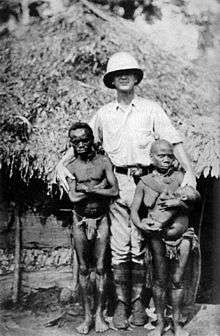
Michael L. McKinney, professor in the Ecology & Evolutionary Biology Department of the University of Tennessee,[49] wrote in 1991 that the "slower growth" of the "African pygmy" is a case of "neoteny".[50]
Europeans
Frederick S. Hulse said that "...modern Europeans are, on average, distinctly less pedomorphic than are most non-Europeans...".[46]
Richard Jantz and Lee Meadows Jantz who are both directors at the Forensic Anthropology Center at the University of Tennessee[51] said white American skulls of both sexes have become less neotenous since the mid-1800s.[38]
Aboriginal Australians
Frederick S. Hulse wrote in 1962 that aboriginal Australians have retained "similar" "skeletal characteristics" to those "which most men possessed in earlier times" (gerontomorphic characteristics) that are "contrary" to the "pedomorphic qualities" which the Bushmen have evolved.[46]
Mongoloids

Montagu said that "The Mongoloid skull has proceeded further than in any other people."[5] "The Mongoloid skull, whether Chinese or Japanese, has been rather more neotenized than the Caucasoid or European."[5] "The female skull, it will be noted, is more pedomorphic in all human populations than the male skull."[5]
Montagu further observed that "the skeleton of the classic Mongoloid type is very delicately made, even down to the character of the sutures of the skull which, like those of the infant skull, are relatively smooth and untortuous. In fact the Mongoloid presents so many physical traits which are associated with the late fetus or young infant that he has been called a fetalized, infantilized or pedomorphic type. Those who have carefully observed young babies may recall that the root of the nose is frequently flat or low as in Mongoloids, and that an internal epicanthic fold in such instances is usually present. The smaller number of individual head hairs and the marked hairlessness of the remainder of the body are infantile traits, as are likewise the small mastoid processes, the shallow fossa into which the jawbone fits (the mandibular fossa), the rather stocky build, the large brain-pan and brain, lack of brow ridges, and quite a number of other characters."[52]
Richard Grossinger wrote that "The intuition that advanced human development was pedomorphic rather than recapitulationary and accelerated was disturbing to many Eurocentric nineteenth century anthropologists."[53] "If juvenilization was the characteristic for advanced status, then it was clear that the Mongoloid races were more deeply fetalized in most respects and thus capable of the greatest development."[53]
Stephen Oppenheimer said, "An interesting hypothesis put forward by paleontologist Stephen Jay Gould many years ago was that the package of the Mongoloid anatomical changes could be explained by the phenomenon of neoteny, whereby an infantile or childlike body form is preserved in adult life. Neoteny in hominids is still one of the simplest explanations of how we developed a disproportionately large brain so rapidly over the past few million years. The relatively large brain and the forward rotation of the skull on the spinal column, and body hair loss, both characteristic of humans, are found in foetal chimps. Gould suggested a mild intensification of neoteny in Mongoloids, in whom it has been given the name pedomorphy. Such a mechanism is likely to involve only a few controller genes and could therefore happen over a relatively short evolutionary period. It would also explain how the counterintuitive retroussé [turned up at the end] nose and relative loss of facial hair got into the package."[54] "[D]ecrease unnecessary muscle bulk, less tooth mass, thinner bones and smaller physical size; ...this follows the selective adaptive model of Mongoloid evolution."[54]
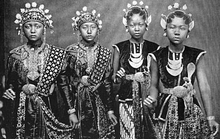

Paul Storm of the Naturalis Biodiversity Center, Netherlands, said that in Australasia there are two types of cranial morphologies—the "Sunda" (Mongoloid) and "Sahul" (Australoid) types. Storm said that the "Sunda" (Mongoloid) type includes Chinese and Javanese people, and he said that the "Sahul" (Australoid) type includes Papuans and Australian aborigines. Storm said that the "Sunda" (Mongoloid) type has a flat face with high cheek bones, and Storm said that this "flat face" of the Chinese and Javanese is known as the "mongoloid face". Storm further said that the "Sunda" (Mongoloid) type has a more rounded skull, "feminine (juvenile) characters", a "retention of juvenile characters" and a limited outgrowth of superstructures such as the supraorbital region. Storm said that "Sunda" (Mongoloid) skulls resemble female skulls more than "Sahul" (Australoid) skulls resemble female skulls. Storm said that the skulls of "Asian" males ("Chinese and Javanese") have "more feminine characteristics", and he said that they have "many feminine characters in contrast with Australians".[55]
Paul Storm said that Asia contained humans with "generalized" cranial morphology, but between 20,000 BP and 12,000 BP this generalized type disappeared as a new type emerged. This new type had a flatter face with more pronounced cheekbones, a more rounded head, reduced sexual dimorphism (male skulls started to resemble female skulls), a reduction of supestructures such as the supraorbital region and an increased "retention of juvenile characters". Storm said that this new type of skull that emerged is called the "Proto-Sunda" (Proto-Mongoloid) type, and it is distinguished from the "Sunda" (Mongoloid) type by being more "robust". Storm said that the "Mongoloid" or "Asian" type of skull developed relatively fast during a population bottleneck in Asia that happened during the Late Pleistocene or Early Holocene through a microevolutionary trend that involved a "continuation of neoteny and gracilisation trends". Due to different courses of evolution, Storm said that these two types of skulls, the "Sunda" (Mongoloid) type and the "Sahul" (Australoid) type, are now clearly recognizable at the present time.[55]

Andrew Arthur Abbie who was an anatomist and anthropologist at the University of Adelaide[56] talked about leg-to-torso length being related to neoteny. Abbie said that women normally have shorter legs than men, and he said that shorter legs are the normal condition in some ethnic groups such as Mongoloids. Abbie said that Mongoloids of whom he listed the people of "China, Japan and the Americas" have proportionately larger heads and shorter legs than Europeans, and he said that this is a case of "paedomorphism". Abbie said that aboriginal Australians and some African ethnic groups such as the "Negro", the "Hottentot" and the "Nubian" peoples have proportionately longer legs than Europeans, and he said that this is a case of "gerontomorphism". Abbie said that ethnic groups with proportionately shorter legs than Europeans are relatively "paedomorphic" in terms of leg-to-torso ratios when compared to Europeans, and he said that ethnic groups with proportionately longer legs than Europeans are relatively "gerontomorphic" in terms of leg-to-torso ratios when compared to Europeans.[57]
William Ernest Castle said that the difference in limb proportions between the relatively short-limbed "Chiriguan" amerindian and the relatively long-limbed "Dinka negro" is the "same" as the difference in limb proportions between "boy and man". He said that there could be an ontogenic cause that produces "long-continued growth" in populations that characteristically have relatively longer limbs, and he said that the differences in height between the races could be due to "interruptions at different stages of the general growth process".[58]
Leonard Halford Dudley Buxton who taught physical anthropology at Oxford University[59] said that in the "Yellow man" the depression of the nose is below the nasion rather than at the place where the nasal bones meet the frontal bone like in the "European races". Buxton said that in the "Yellow man" the nasal bones form a wider angle rather than the narrower angle of the "European races". Buxton said that these features of the nose of the "Yellow man" make it "flatter" and "not unlike that found in European children". Buxton said that "Yellow men" have the "Mongolian fold", and Buxton said that this "fold occurs occasionally in European children, and sometimes even in adults". Buxton said that the presence of the "Mongolian fold" in "Yellow men" is possibly due to the shape of the nose of "Yellow men" that "in some cases resemble that of European children".[60]
Negroids

Ashley Montagu said that Negroids have the following neotenous traits relative to Caucasoids: flattish nose, flat roof of the nose, small ears, narrower joints, frontal skull eminences, later closure of the premaxillary sutures, less hairy, longer eyelashes and cruciform pattern of the lower second and third molars.[5]
Specific neotenies
Populations with a history of dairy farming have evolved to be lactose tolerant in adulthood, whereas other populations generally lose the ability to break down lactose as they grow into adults.[61]
Down syndrome neotenizes the brain and body.[62] The syndrome is characterized by decelerated maturation (neoteny), incomplete morphogenesis (vestigia) and atavisms.[63]
See also
References
- ↑ Lamarre, Thomas (2009). The Anime Machine: A Media Theory of Animation. University Of Minnesota Press. ISBN 0816651558.
- ↑ "Most Neotenous in the World: Japan". Seminal Thought. 14 June 2013. Retrieved 16 December 2015.
- 1 2 3 4 5 6 7 Bednarik, R. G. (2011). "The Human Condition". doi:10.1007/978-1-4419-9353-3. ISBN 978-1-4419-9352-6. (page 134), cited by:
Achrati, Ahmed (November 2014). "Neoteny, female hominin and cognitive evolution". Rock Art Research. 31 (1): 232–238.
"In humans, neoteny is manifested in the resemblance of many physiological features of a human to a late-stage foetal chimpanzee. These foetal characteristics include hair on the head, a globular skull, ear shape, vertical plane face, absence of penal bone (baculum) in foetal male chimpanzees, the vagina pointing forward in foetal ape, the presence of hymen in neonate ape, and the structure of the foot. 'These and many other features', Bednarik says, 'define the anatomical relationship between ape and man as the latter's neoteny'". - 1 2 3 Gould, S.J. (1977) Ontogeny and Phylogeny, Cambridge: Belknap Press.
- 1 2 3 4 5 6 7 8 9 10 11 12 13 14 15 16 Montagu, Ashley. Growing Young. Published by Greenwood Publishing Group, 1989. ISBN 0-89789-167-8
- 1 2 Jean-Baptiste de Panafieu, P. (2007). Evolution. Seven Stories Press, USA.
- ↑ "Why Do Men Find Women With Larger Eyes Attractive?". Zidbits - Learn something new everyday!.
- ↑ Smith, J.M. (1958). The theory of evolution. Cambridge University Press.
- 1 2 Henke, W. (2007). Handbook of paleoanthropology, Volume 1. Springer Books, NY.
- ↑ Hetherington, R. (2010). The Climate Connection: Climate Change and Modern Human Evolution. Cambridge University Press.
- ↑ Barry Bogin (6 May 1999). Patterns of Human Growth. Cambridge University Press. p. 159. ISBN 978-0-521-56438-0.
- ↑ Gould, S.J. A Biological Homage to Mickey Mouse.
- 1 2 Thiessen, D.D. (1997). Bittersweet destiny: the stormy evolution of human behavior. Transaction Publishers, N.J.
- 1 2 Gould, S.J. (1996). The mismeasure of man. W.W. Norton and Company, N.Y.
- 1 2 Jones, D.; et al. (1995). "Sexual selection, physical attractiveness, and facial neoteny: Cross-cultural evidence and implications [and comments and reply]". Current Anthropology. 36 (5): 723–748. doi:10.1086/204427.
- 1 2 Collins, Desmond et al. (1973). Background to archaeology: Britain in its European setting. Cambridge: Cambridge University Press. ISBN 0-521-20155-1 hard cover
- 1 2 Montagu, A. (1955). Time, morphology, and neoteny in the evolution of man. In American Anthropologist.
- ↑ The First Idea, Shanker and Greenspan, 2004, p. 130
- 1 2 Rantala, M.J. (2006). Evolution of nakedness in Homo sapiens. In Zoology.
- ↑ Shea, BT (1989). "Heterochrony in human evolution: the case for neoteny reconsidered". American Journal of Physical Anthropology. 80: 69–101. doi:10.1002/ajpa.1330320505.
- ↑ Hall, B.K., Hallgrímsson, B. Monroe, W.S. (2008). Strickberger's evolution: the integration of genes, organisms and populations. Jones and Bartlett Publishers: Canada.
- ↑ "Special Issue: Early Man". World Archaeology Volume. 2 (1): 112. 1970. doi:10.1080/00438243.1970.9979467.
- ↑ Bogin, B. (1997). "Evolutionary Hypotheses for Human Childhood". Yearbook of Physical Anthropology. 40: 63–89. doi:10.1002/(sici)1096-8644(1997)25+<63::aid-ajpa3>3.0.co;2-8.
- ↑ Simpson, J.A. & Kenrick, D.T. (1997). Evolutionary Social Psychology. Lawrence Erlbaum Associates, Inc. ISBN 978-0-805-81905-2 (hbk)
- ↑ Keating, C.F.; et al. (2003). "Do Babyfaced Adults Receive More Help? The (Cross-Cultural) Case of the Lost Resume" (PDF). Journal of Nonverbal Behavior. 27 (2): 89–109. doi:10.1023/A:1023962425692.
- ↑ Nyborg, H. (1994). Hormones, sex and society: The science of physicology. Westport, CT: Greenwood Publishing Group, Inc. ISBN 0-275-94608-8
- ↑ Fifteen eighty four: Academic Perspectives from Cambridge University Press. Author: Aldo Poiani. Accessed October 31, 2014, from link
- ↑ Poiani, A. (2010). Animal Homosexuality: A biosocial perspective. Cambridge University Press: Cambridge, U.K. ISBN 978-0-521-19675-8 Hardback
- ↑ Robertson, J.M. (2014). Astrocytes and the evolution of the human brain. In Medical Hypotheses. (82)2. Pages 236–239
- ↑ Somel, M.; et al. (2009). "Transcriptional neoteny in the human brain". Proceedings of the National Academy of Sciences. 106: 14. doi:10.1073/pnas.0900544106.
- ↑ http://www.nytimes.com/2006/12/10/magazine/10section3a.t-3.html?_r=0
- ↑ Young J.Z. 1957; 2nd ed 1975. The life of mammals. Oxford.
- ↑ Thompson, T. & Black, S. (2007). Forensic Human Identification: An Introduction. Boca Raton, FL: Taylor and Francis Group. ISBN 0-8493-3954-5 (Hardcover)
- ↑ Jones, D. Sexual Selection, Physical Attractiveness and Facial Neoteny: Cross-Cultural Evidence and Implications. p.723.
- 1 2 3 4 5 6 7 8 Cunningham, M.; Roberts, A.; Vu, C. (1995). "Their ideas of beauty are, on the whole, the same as ours": consistency and variability in the cross-cultural perception of female physical attractiveness". Journal of Personality and Social Psychology. 68 (2): 261–79. doi:10.1037/0022-3514.68.2.261.
- ↑ Chiarella Sforza, Alberto Laino, Raoul D'Alessio, Gaia Grandi, Miriam Binelli and Virgilio Ferruccio Ferrario (2009) Soft-Tissue Facial Characteristics of Attractive Italian Women as Compared to Normal Women. The Angle Orthodontist: January 2009, Vol. 79, No. 1, pp. 17-23.
- ↑ Perrett, D.I.; May, K.A.; Yoshikawa, S. (1994). "Facial shape and judgements of female attractiveness". Nature. 368: 239–242. doi:10.1038/368239a0. PMID 8145822.
- 1 2 Elia, I.A. (2013). "A Foxy View of Human Beauty: Implications of the Farm Fox Experiment for Understanding the Origins of Structural and Experiential Aspects of Facial Attractiveness". The Quarterly Review of Biology. 88 (3): 163–183. doi:10.1086/671486.
- 1 2 Montagu, A. (1999). The natural superiority of women (5th ed.). Walnut Creek, CA: AltaMira Press. ISBN 0-7619-8981-1 (cloth: alk. paper)
- ↑ Barrickman, N.T. (2008). Evolutionary Relationship Between Life History and Brain Growth in Anthropoid Primates. Retrieved Jun 1, 2011, from dukespace.lib.duke.edu/dspace/.../D_Barrickman_Nancy_a_200812.pdf?.
- ↑ Montagu, M. F. Ashley (1955). "Time, Morphology, and Neoteny in the Evolution of Man". American Anthropologist. 57 (1): 13–27. doi:10.1525/aa.1955.57.1.02a00030.
- ↑ Alemany Oliver, M. (2016). "Consumer Neoteny: An Evolutionary Perspective on Childlike Behavior in Consumer Society". Evolutionary Psychology. 14 (3): 1–11. doi:10.1177/1474704916661825.
- ↑ Drennan, M.R. (1931). "Pedomorphism in the pre-Bushman skull". American Journal of Physical Anthropology. 16: 203–210. doi:10.1002/ajpa.1330160214.
- ↑ Tobias, P.V. (1959). "Studies on the occipital bone in Africa. V. The occipital curvature in fossil man and the light it throws on the morphogenesis of the Bushman". American Journal of Physical Anthropology. 17: 1–11. doi:10.1002/ajpa.1330170102.
- ↑ Sardi, ML; Ramírez Rozzi, FV (2012). "Different Cranial Ontogeny in Europeans and Southern Africans". PLoS ONE. 7 (4): e35917. doi:10.1371/journal.pone.0035917.
- 1 2 3 Hulse, F.S. (1962). "Race as an Evolutionary Episode". American Anthropologist. 64 (5): 929–945. doi:10.1525/aa.1962.64.5.02a00030.
- ↑ Spencer, F. (1997). History of Physical Anthropology: An Encyclopedia (Vol. 1). USA: Routledge. ISBN 0815304900
- ↑ Schepartz, L.A. (1988). Who were the later Pleistocene eastern Africans? In the African Archaeological Review. Vol. 6. No. 1. pp. 58.
- ↑ McKinney, M.L., Schoch, R.M. & Yonavjak, L. Environmental Science: Systems and Solutions (5th ed.). (2013). USA:Jones & Bartlett Learning. ISBN 978-1-4496-6139-7
- ↑ McKinney M.L. & McNamara, K.J. (1991). Heterochrony: The Evolution of Ontogeny. New York: Plenum Press. ISBN 978-1-4757-0775-5
- ↑ University of Tennessee, Knoxville. Faculty and Staff. (no date). Retrieved on July 30, 2015, from link
- ↑ Montagu, A. (1951). An introduction to physical anthropology: A revised second edition. Charles C. Thomas Publisher: Springfield, Illinois, USA.
- 1 2 Grossinger, Richard. Embryogenesis. Published by North Atlantic Books, 2000. ISBN 1-55643-359-X
- 1 2 Oppenheimer, Stephen. The Real Eve. Published by Carroll & Graf Publishers, 2003. ISBN 0-7867-1192-2
- 1 2 Storm, P. The evolutionary significance of the Wajak skulls. — Scripta Geol., 110: 1-247, figs. 1-30, tabs. 1-121, Leiden, September 1995.
- ↑ Ronald Elmslie and Susan Nance, 'Abbie, Andrew Arthur (1905–1976)', Australian Dictionary of Biography, National Centre of Biography, Australian National University, link, published first in hardcopy 1993, accessed online 18 November 2014.
- ↑ Abbie, A.A. (1964). "The Factor Timing in Emergence Distinctively Human Characters". Papers and proceedings of the Royal Society of Tasmania. 98: 63–71.
- ↑ Castle, W.E. (1922). Genetic studies of rabbits and rats. Carnegie Institution of Washington:Washington, D.C.
- ↑ Pitt Rivers Museum, University of Oxford. The Invention of Museum Anthropology, 1850-1920: Scoping the local material resources for an intellectual history of a global discipline. Measuring the Natives: Beatrice Blackwood and Leonard Dudley Buxton's work in Oxfordshire. Accessed October 29, 2014, from link
- ↑ Dudley Buxton, L.H. (1925). The Peoples of Asia. Routledge, Trench Trubner: New York, N.Y.
- ↑ Johnson, S. Religion, Science and other Neotenous Behaviour.
- ↑ Opitz, John M.; Gilbert-Barness, Enid F. (1990). "Reflections on the Pathogenesis of Down Syndrome". American Journal of Medical Genetics. 7: 44. doi:10.1002/ajmg.1320370707. PMID 2149972.
- ↑ Optiz, J.M. (1990). Reflections on the pathogenesis of Down syndrome. American Journal of Medical Genetics Supplement. 7:38.
External links
- Wehr, Paul; MacDonald, K; Linder, R; Yeung, G (2001). "Stabilizing and directional selection on facial paedomorphosis". Human Nature. 12: 383–402. doi:10.1007/s12110-001-1004-z.
- Bergstrom, Carl T. and Dugatkin, Lee Alan. "Evolution" W. W. Norton, 2012.


